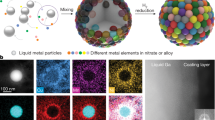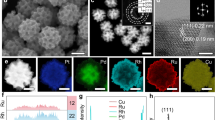Abstract
High-entropy alloys (HEAs) consisting of five or more elements have gained considerable attention due to their distinctive properties. However, synthesizing monodisperse HEA nanoparticles (NPs) is challenging through colloidal chemistry due to differences in the reduction rates of metal precursors and poor understanding of reaction intermediates. Here we propose a general approach to HEA NPs through an NP conversion pathway, where two-phase core–shell NPs are predictably synthesized via colloidal chemistry and then converted into single-phase HEA NPs by thermal annealing. This study establishes the necessary synthesis principles for the precursor core–shell NPs by considering the relative redox potentials of metal or metal precursors and the inherent lattice properties of the selected metals. Once monodisperse core–shell NPs were synthesized, they were converted into single-phase HEA NPs (constituent metals studied include Pd, Cu, Pt, Ni, Co, Au, Ag and Sn) by a simple annealing procedure that is suitable for different NP supports. We demonstrate the ability to manipulate the degree of intermixing between the core and shell phases and the generality of this NP conversion strategy to monodisperse HEA NPs.

This is a preview of subscription content, access via your institution
Access options
Subscribe to this journal
Receive 12 digital issues and online access to articles
$119.00 per year
only $9.92 per issue
Buy this article
- Purchase on Springer Link
- Instant access to full article PDF
Prices may be subject to local taxes which are calculated during checkout





Similar content being viewed by others
Data availability
The data that substantiate the study’s findings and contribute to the assessment of the paper’s conclusions can be accessed within the paper and its Supplementary Information. Source data are provided with this paper.
References
George, E. P., Raabe, D. & Ritchie, R. O. High-entropy alloys. Nat. Rev. Mater. 4, 515–534 (2019).
Zhou, M., Li, C. & Fang, J. Noble-metal based random alloy and intermetallic nanocrystals: syntheses and applications. Chem. Rev. 121, 736–795 (2021).
Yeh, J.-W. et al. Nanostructured high-entropy alloys with multiple principal elements: novel alloy design concepts and outcomes. Adv. Eng. Mater. 6, 299–303 (2004).
Cantor, B., Chang, I. T. H., Knight, P. & Vincent, A. J. B. Microstructural development in equiatomic multicomponent alloys. Mater. Sci. Eng. A 375–377, 213–218 (2004).
Wang, B. et al. General synthesis of high-entropy alloy and ceramic nanoparticles in nanoseconds. Nat. Synth. 1, 138–146 (2022).
Ding, Q. et al. Tuning element distribution, structure and properties by composition in high-entropy alloys. Nature 574, 223–227 (2019).
Banko, L. et al. Unravelling composition–activity–stability trends in high entropy alloy electrocatalysts by using a data-guided combinatorial synthesis strategy and computational modeling. Adv. Energy Mater. 12, 2103312 (2022).
Bueno, S. L. A. et al. Quinary, senary, and septenary high entropy alloy nanoparticle catalysts from core@shell nanoparticles and the significance of intraparticle heterogeneity. ACS Nano 16, 18873–18885 (2022).
Chen, Y. et al. Synthesis of monodisperse high entropy alloy nanocatalysts from core@shell nanoparticles. Nanoscale Horiz. 6, 231–237 (2021).
Feng, G. et al. Sub-2 nm ultrasmall high-entropy alloy nanoparticles for extremely superior electrocatalytic hydrogen evolution. J. Am. Chem. Soc. 143, 17117–17127 (2021).
Zhan, C. et al. Subnanometer high-entropy alloy nanowires enable remarkable hydrogen oxidation catalysis. Nat. Commun. 12, 6261 (2021).
Yao, Y. et al. Carbothermal shock synthesis of high-entropy-alloy nanoparticles. Science 359, 1489–1494 (2018).
Dey, G. R., McCormick, C. R., Soliman, S. S., Darling, A. J. & Schaak, R. E. Chemical insights into the formation of colloidal high entropy alloy nanoparticles. ACS Nano 17, 5943–5955 (2023).
Cao, G. et al. Liquid metal for high-entropy alloy nanoparticles synthesis. Nature 619, 73–77 (2023).
Li, H. et al. Fast site-to-site electron transfer of high-entropy alloy nanocatalyst driving redox electrocatalysis. Nat. Commun. 11, 5437 (2020).
Silva, C. M. D. et al. Colloidal synthesis of nanoparticles: from bimetallic to high entropy alloys. Nanoscale 14, 9832–9841 (2022).
Broge, N. L. N., Bertelsen, A. D., Søndergaard-Pedersen, F. & Iversen, B. B. Facile solvothermal synthesis of Pt–Ir–Pd–Rh–Ru–Cu–Ni–Co high-entropy alloy nanoparticles. Chem. Mater. 35, 144–153 (2023).
Ortiz, N. & Skrabalak, S. E. On the dual roles of ligands in the synthesis of colloidal metal nanostructures. Langmuir 30, 6649–6659 (2014).
Gilroy, K. D., Ruditskiy, A., Peng, H.-C., Qin, D. & Xia, Y. Bimetallic nanocrystals: syntheses, properties, and applications. Chem. Rev. 116, 10414–10472 (2016).
Loiudice, A. & Buonsanti, R. Reaction intermediates in the synthesis of colloidal nanocrystals. Nat. Synth. 1, 344–351 (2022).
De Roo, J. Chemical considerations for colloidal nanocrystal synthesis. Chem. Mater. 34, 5766–5779 (2022).
Muzzio, M. et al. Monodisperse nanoparticles for catalysis and nanomedicine. Nanoscale 11, 18946–18967 (2019).
McCormick, C. R., Katzbaer, R. R., Steimle, B. C. & Schaak, R. E. Combinatorial cation exchange for the discovery and rational synthesis of heterostructured nanorods. Nat. Synth. 2, 152–161 (2023).
Vasquez, Y., Henkes, A. E., Chris Bauer, J. & Schaak, R. E. Nanocrystal conversion chemistry: a unified and materials-general strategy for the template-based synthesis of nanocrystalline solids. J. Solid State Chem. 181, 1509–1523 (2008).
Xia, X., Wang, Y., Ruditskiy, A. & Xia, Y. 25th anniversary article: galvanic replacement: a simple and versatile route to hollow nanostructures with tunable and well-controlled properties. Adv. Mater. 25, 6313–6333 (2013).
Gamler, J. T. L. et al. Achieving highly durable random alloy nanocatalysts through intermetallic cores. ACS Nano 13, 4008–4017 (2019).
DeSantis, C. J., Sue, A. C., Bower, M. M. & Skrabalak, S. E. Seed-mediated co-reduction: a versatile route to architecturally controlled bimetallic nanostructures. ACS Nano 6, 2617–2628 (2012).
Lide, D. R. CRC Handbook of Chemistry and Physics, 89th ed. (CRC Press, Taylor & Francis: Boca Raton, FL, 2008).
Kar, N. et al. Reaction stoichiometry directs the architecture of trimetallic nanostructures produced via galvanic replacement. Nanoscale 15, 3749–3756 (2023).
Ashberry, H. M., Gamler, J. T. L., Unocic, R. R. & Skrabalak, S. E. Disorder-to-order transition mediated by size refocusing: a route toward monodisperse intermetallic nanoparticles. Nano Lett. 19, 6418–6423 (2019).
Vegard, L. & Dale, H. VIII. Untersuchungen über Mischkristalle und Legierungen. Z. Krist. Cryst. Mater 67, 148–162 (1928).
Sun, D. et al. Monodisperse AgPd alloy nanoparticles as a highly active catalyst towards the methanolysis of ammonia borane for hydrogen generation. RSC Adv. 6, 105940–105947 (2016).
Sun, D., Mazumder, V., Metin, Ö. & Sun, S. Catalytic hydrolysis of ammonia borane via cobalt palladium nanoparticles. ACS Nano 5, 6458–6464 (2011).
mp-1022725: Sn (Cubic, Fm-3m, 225). The Materials Project https://materialsproject.org/materials/mp-1022725?chemsys=Sn#literature_references (2023)
Almeida, T. S., Van Wassen, A. R., VanDover, R. B., de Andrade, A. R. & Abruña, H. D. Combinatorial PtSnM (M = Fe, Ni, Ru and Pd) nanoparticle catalyst library toward ethanol electrooxidation. J. Power Sources 284, 623–630 (2015).
Rizo, R. et al. Pt-Richcore/Sn-Richsubsurface/Ptskin nanocubes as highly active and stable electrocatalysts for the ethanol oxidation reaction. J. Am. Chem. Soc. 140, 3791–3797 (2018).
Zhao, X., Yang, Q. & Quan, Z. Tin-based nanomaterials: colloidal synthesis and battery applications. Chem. Commun. 55, 8683–8694 (2019).
Kravchyk, K. et al. Monodisperse and inorganically capped Sn and Sn/SnO2 nanocrystals for high-performance Li-ion battery anodes. J. Am. Chem. Soc. 135, 4199–4202 (2013).
Bueno, S. L. A., Zhan, X., Wolfe, J., Chatterjee, K. & Skrabalak, S. E. Phase-controlled synthesis of Pd–Sn nanocrystal catalysts of defined size and shape. ACS Appl. Mater. Interfaces 13, 51876–51885 (2021).
Ashberry, H. M., Zhan, X. & Skrabalak, S. E. Identification of nanoscale processes associated with the disorder-to-order transformation of carbon-supported alloy nanoparticles. ACS Mater. Au 2, 143–153 (2022).
Gao, S. et al. Synthesis of high-entropy alloy nanoparticles on supports by the fast moving bed pyrolysis. Nat. Commun. 11, 2016 (2020).
Hansen, P. L. et al. Atom-resolved imaging of dynamic shape changes in supported copper nanocrystals. Science 295, 2053–2055 (2002).
Xie, C., Niu, Z., Kim, D., Li, M. & Yang, P. Surface and interface control in nanoparticle catalysis. Chem. Rev. 120, 1184–1249 (2020).
Harak, E. W., Koczkur, K. M., Harak, D. W., Patton, P. & Skrabalak, S. E. Designing efficient catalysts through bimetallic architecture: Rh@Pt nanocubes as a case study. ChemNanoMat 3, 815–821 (2017).
Acknowledgements
S.E.S., N.K., M.M., I.H.S., J.W. and S.L.A.B. acknowledge financial support from Indiana University and the US National Science Foundation (NSF CHE 2203349 received by S.E.S.). The authors acknowledge support from Indiana University’s Electron Microscopy Center, XPS facility (access to XPS at the Nanoscale Characterization Facility was provided by the NSF Award DMR MRI-1126394 received by S.E.S.), and Nanoscale Characterization Facility for access to instrumentation. They also thank X. Zhan, E. Verma and Y. Losovyj for their helpful discussions.
Author information
Authors and Affiliations
Contributions
N.K. and S.E.S. were responsible for the project concept and design of experiments. N.K. developed the synthesis of bimetallic and core–shell NPs and characterizations. M.M. and J.W. helped in synthesis of AuCu and Pd3Sn core–shell NP synthesis, respectively. I.H.S. contributed in temperature-dependent experiments. S.L.A.B. contributed some STEM–EDS characterization as well as some control experiments. This manuscript was written through the contributions of all authors. All authors have given approval to the final version of this manuscript.
Corresponding author
Ethics declarations
Competing interests
The authors declare no competing financial interest.
Peer review
Peer review information
Nature Synthesis thanks Zhiming Li and the other, anonymous, reviewer(s) for their contribution to the peer review of this work. Alexandra Groves, in collaboration with the Nature Synthesis team.
Additional information
Publisher’s note Springer Nature remains neutral with regard to jurisdictional claims in published maps and institutional affiliations.
Supplementary information
Supplementary Information
Supplementary Figs. 1–43, discussion, Table 1, Notes 1 and 2, and references.
Source data
Source Data Fig. 2
Unprocessed data of STEM–EDS linescan and SEM–EDS spectra.
Source Data Fig. 3
Unprocessed data of STEM–EDS linescan and SEM–EDS spectra.
Source Data Fig. 4
Unprocessed data of STEM–EDS linescan and SEM–EDS spectra.
Source Data Fig. 5
Unprocessed data of STEM–EDS linescan, XRD pattern and individual XPS spectra.
Rights and permissions
Springer Nature or its licensor (e.g. a society or other partner) holds exclusive rights to this article under a publishing agreement with the author(s) or other rightsholder(s); author self-archiving of the accepted manuscript version of this article is solely governed by the terms of such publishing agreement and applicable law.
About this article
Cite this article
Kar, N., McCoy, M., Wolfe, J. et al. Retrosynthetic design of core–shell nanoparticles for thermal conversion to monodisperse high-entropy alloy nanoparticles. Nat. Synth 3, 175–184 (2024). https://doi.org/10.1038/s44160-023-00409-0
Received:
Accepted:
Published:
Issue Date:
DOI: https://doi.org/10.1038/s44160-023-00409-0



